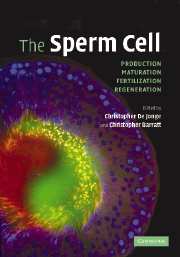Book contents
- Frontmatter
- Contents
- Preface
- List of contributors
- 1 Mammalian spermatogenesis and sperm structure: anatomical and compartmental analysis
- 2 Sperm chromatin stability and susceptibility to damage in relation to its structure
- 3 Genomic and proteomic approaches to defining sperm production and function
- 4 Sperm maturation in the human epididymis
- 5 Controls of sperm motility
- 6 Regulation of capacitation
- 7 Reactive oxygen species: friend or foe
- 8 Testing sperm manufacturing quality: the sperm–zona binding assay
- 9 Genetics: a basic science perspective
- 10 Sex chromosome abnormalities and male infertility: a clinical perspective
- 11 Epigenetic patterning in male germ cells: importance of DNA methylation to progeny outcome
- 12 The DAZ gene family and human germ cell development from embryonic stem cells
- Index
10 - Sex chromosome abnormalities and male infertility: a clinical perspective
Published online by Cambridge University Press: 14 August 2009
- Frontmatter
- Contents
- Preface
- List of contributors
- 1 Mammalian spermatogenesis and sperm structure: anatomical and compartmental analysis
- 2 Sperm chromatin stability and susceptibility to damage in relation to its structure
- 3 Genomic and proteomic approaches to defining sperm production and function
- 4 Sperm maturation in the human epididymis
- 5 Controls of sperm motility
- 6 Regulation of capacitation
- 7 Reactive oxygen species: friend or foe
- 8 Testing sperm manufacturing quality: the sperm–zona binding assay
- 9 Genetics: a basic science perspective
- 10 Sex chromosome abnormalities and male infertility: a clinical perspective
- 11 Epigenetic patterning in male germ cells: importance of DNA methylation to progeny outcome
- 12 The DAZ gene family and human germ cell development from embryonic stem cells
- Index
Summary
Introduction
Although abnormalities of the Y chromosome have been associated with male infertility since 1976 (Tiepolo and Zuffardi, 1976), it was only in the last decade that the Y chromosome was shown to have regions and genes that govern spermatogenesis. More recently, it has become clear that the X chromosome may be just as important as the Y chromosome in determining male fertility potential. This chapter will review our current understanding of the genotype–phenotype relationships that underlie abnormalities of both the X and Y chromosomes, and discuss recognized syndromes of the gonosomes that are known to cause male infertility.
Y chromosome
Over the last 10 years, there has been significant progress both in analyzing the molecular structure of the Y chromosome and understanding the relationship of Y chromosome mutations to infertility phenotypes. Before its firm association with male fertility, the Y chromosome was widely considered a genetic black hole, a chromosome that evolved as a broken remnant of the X chromosome. It was clear that the Y harbored the male sex-determining region (testis-determining region or sex-determining region Y (SRY)), but it was also home to gene regions that govern stature, tooth enamel and hairy ears as well as ‘junk’ gene regions. Now that the genome of the human Y is known, we realize that this chromosome is structurally unique as a fertility chromosome.
Azoospermia factor
The postulation that deletions in the long arm of the Y chromosome cause azoospermia was made 30 years ago (Tiepolo and Zuffardi, 1976).
- Type
- Chapter
- Information
- The Sperm CellProduction, Maturation, Fertilization, Regeneration, pp. 261 - 278Publisher: Cambridge University PressPrint publication year: 2006
- 3
- Cited by



